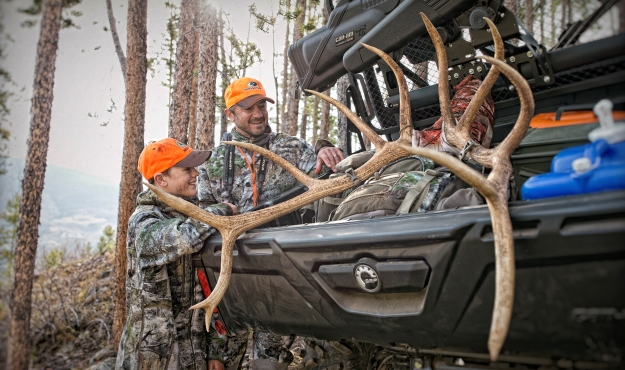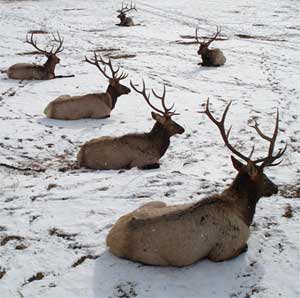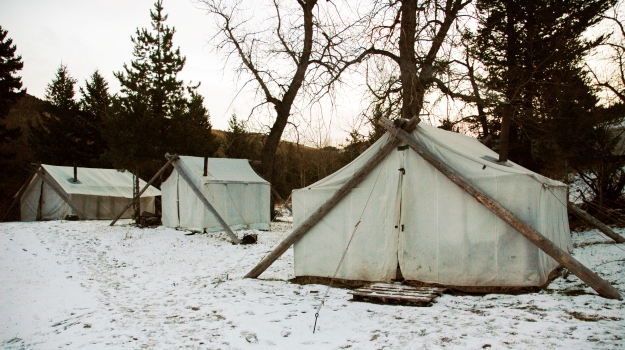
The first and most important equipment for a late-season elk hunt is a quality pair of waterproof boots. You don’t want to show up in camp with your new boots still in the cardboard shipping box. You should have your boots broken in and know that you can wear them without getting blisters and without getting your feet wet. You may want to consider bringing a pack boot that has a rubberized sole and bottom, and usually 12 – 14 inch tall uppers. The pack boot usually also has a heavy insulated liner that adds more warmth to the boot and keeps your feet much more comfortable when you're hunting in snow or water. You want to wear some type of wicking sock that pulls moisture away from your feet. On top of that sock, you want to have a heavier sock that will pull moisture away from your feet too, but the second sock is primarily for warmth. I like Merino wool socks. You also want to have good gloves. Your feet and hands are the two areas that will get coldest the quickest. So, you may want to have a mitten over your fingers and be able to pull that mitten back to can use your fingers when needed. They even make these types of gloves to accommodate a hand warmer.
Next, you need to wear a quality base layer - the layer of clothing that goes right next to your skin. I prefer Merino wool for my base layer, which performs two jobs. It wicks away your sweat, and it’s the first layer of warmth you'll feel. But the next layer (the insulating layer) is what will keep and help you maintain the heat that your body produces. I like either a down layer or some of these new high-tech, well-insulated materials for my second layer.
Then you want an outer layer of clothing that will protect you from the rain and the snow and help hold in your body heat. You'll probably want to leave your baseball hats at home and get a beanie that’s soft and warm and comes down over your ears and/or a balaclava that not only covers your head but also covers your nose, chin and neck front and back. On top of that, you want to make sure your outerwear has a comfortable hood that you can pull up and over your beanie or balaclava to keep your head from getting wet and the wind from chilling your head. You can lose a large percentage of your body heat from your head, if it’s not properly covered. Another advantage to wearing the beanie or balaclava is that this type of headgear can help to keep you warm if you're sleeping in a cold tent at base camp. I suggest wearing Merino wool pants, because your legs will be subject to getting wet in the snow and the rain. Merino wool is one of the most effective garments I know of to protect your legs and lower body, even if the wool gets wet. I also like wool, because it’s much quieter than hard-shell outerwear pants.
Now, let’s talk about your daypack or really your survival kit. Make sure you have an ample supply of chemical hand and body warmers in your pack, which feel great and generate quite a bit of heat on cold, snowy and/or rainy days. Also, keep a good supply of waterproof matches and some type of fire starter. If you're hunting in rain, snow or wind, you’ve got to have some type of fire starter that instantly will be hot enough to dry out twigs and branches to enable you to get the fire going well enough to catch onto larger sticks and branches. A fire not only gives you warmth, if you have to stop and get warm during the day, but if you have to spend the night, the fire provides warmth and gives you a psychological feeling of well being. You also need a portable saw. I like the small fold-up Gerber saw. I use it to cut off larger limbs and branches to help build-up my fire, once I get it going. I carry powdered hot chocolate and dehydrated chicken soup, and a cup or a small pot to use to heat these up to provide good nutrition, energy and warmth to my body. I also take candy to give me a quick boost of instant energy.
 Too, I have all my field-dressing tools with me that I need to field dress and quarter an elk when we take one, and I keep an assortment of skinning blades and knives. In the late season, I make sure I have two extra pairs of heavyweight Merino wool socks to help keep my feet warm and dry. I also put in a couple of extra pairs of Merino wool glove liners, so if my hands or my gloves get wet, I've got some extra glove liners that I can use to keep my hands warm. I also carry an extra pair of sunglasses. In the late season when the sun comes out, there is a real glare on the snow. A quality pair of sunglasses helps cut that glare and reduces eye fatigue.
Too, I have all my field-dressing tools with me that I need to field dress and quarter an elk when we take one, and I keep an assortment of skinning blades and knives. In the late season, I make sure I have two extra pairs of heavyweight Merino wool socks to help keep my feet warm and dry. I also put in a couple of extra pairs of Merino wool glove liners, so if my hands or my gloves get wet, I've got some extra glove liners that I can use to keep my hands warm. I also carry an extra pair of sunglasses. In the late season when the sun comes out, there is a real glare on the snow. A quality pair of sunglasses helps cut that glare and reduces eye fatigue.
Except for having to carry a little more gear with you and having to be more cautious due to the weather, I believe that late-season elk hunting often offers a better opportunity to see and have a better chance of taking elk than the early season does. On late-season hunts, you’ll see much more game, which makes the hunt more exciting and fun. The terrain is usually more opened-up, and you can see the elk better than you can in early season, especially if some snow is on the ground. Seeing those dark-colored elk against a white, snowy background is much easier than trying to see an elk when the leaves and bushes are in full foliage.
Most early-season elk hunters are very diligent about controlling human odor. Even in the late season, we still have to do all we can to control our human odor. Another thing you want to remember is you have to change camouflage from early-season to late-season elk hunting. Early-season camouflage has more dark colors to help you blend in with the foliage. I recommend both the Brush and the new Mountain Country Mossy Oak patterns. These two Mossy Oak patterns are what I recommend for hunters who are hunting in the late season, because they are much more open patterns that blend in well in snow country and the terrain in the mountains.
Day 4: What You Must Understand about Weather - When to Hold and When to Fold



























